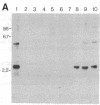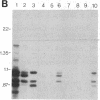Abstract
We describe a class of human repetitive DNA, called beta satellite, that, at a most fundamental level, exists as tandem arrays of diverged approximately equal to 68-base-pair monomer repeat units. The monomer units are organized as distinct subsets, each characterized by a multimeric higher-order repeat unit that is tandemly reiterated and represents a recent unit of amplification. We have cloned, characterized, and determined the sequence of two beta satellite higher-order repeat units: one located on chromosome 9, the other on the acrocentric chromosomes (13, 14, 15, 21, and 22) and perhaps other sites in the genome. Analysis by pulsed-field gel electrophoresis reveals that these tandem arrays are localized in large domains (50-300 kilobase pairs) that are marked by restriction fragment length polymorphisms. In total, beta satellite sequences comprise several million base pairs of DNA in the human genome. Analysis of this DNA family should permit insights into the nature of chromosome-specific and nonspecific modes of satellite DNA evolution and provide useful tools for probing the molecular organization and concerted evolution of the acrocentric chromosomes.
Full text
PDF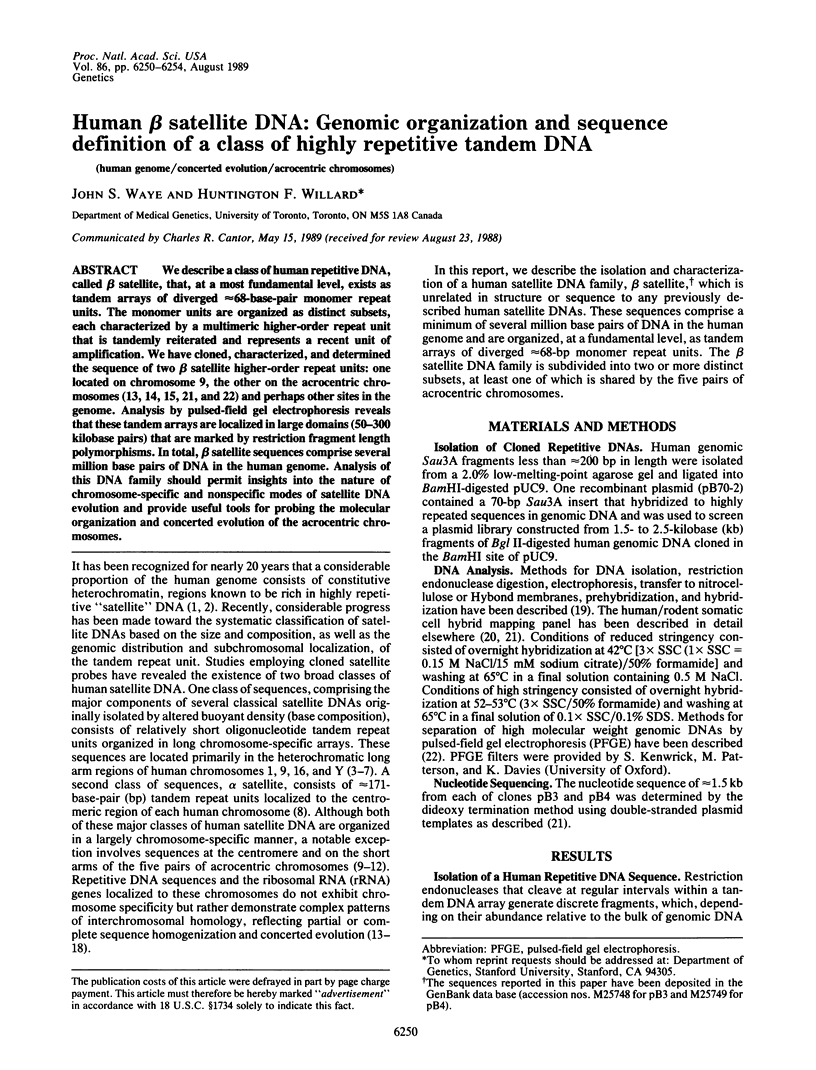
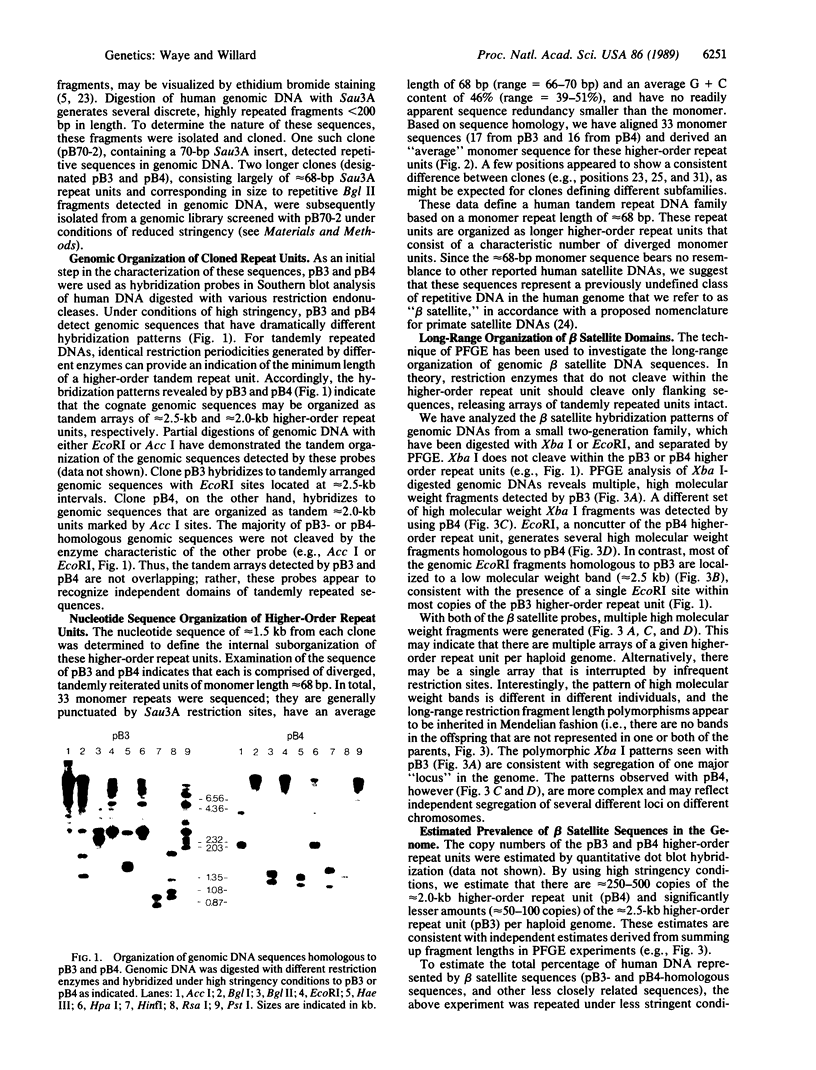
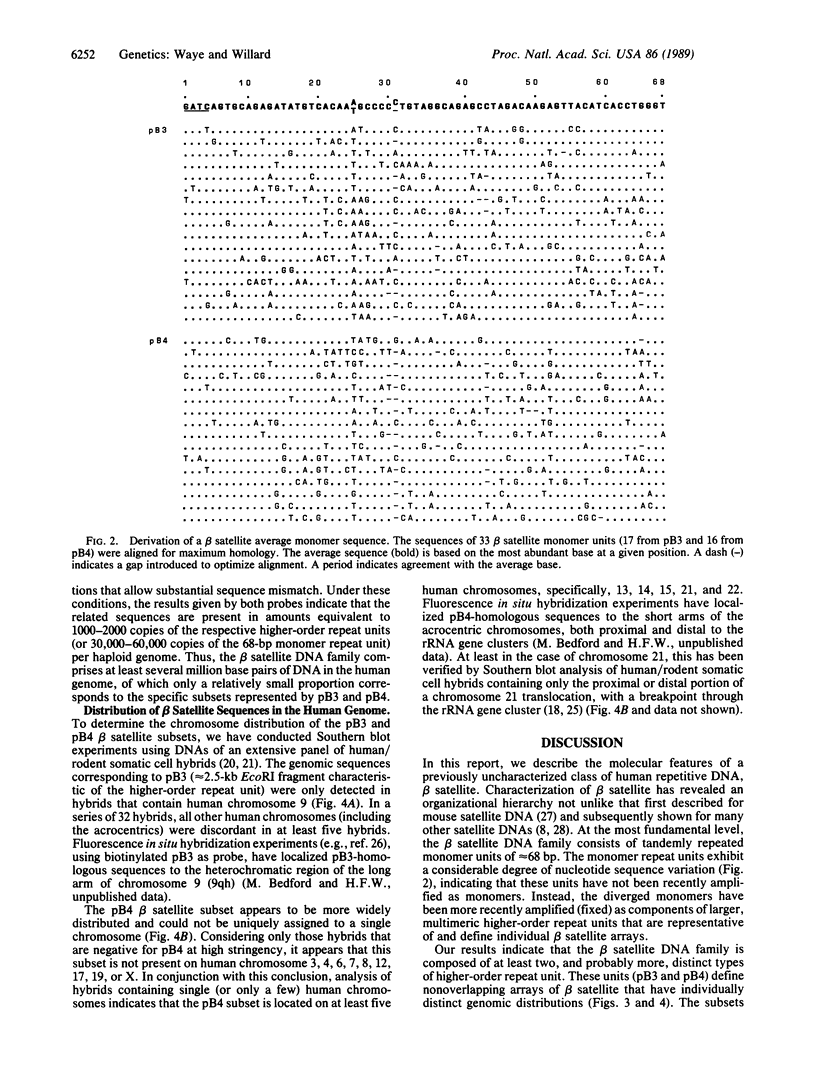
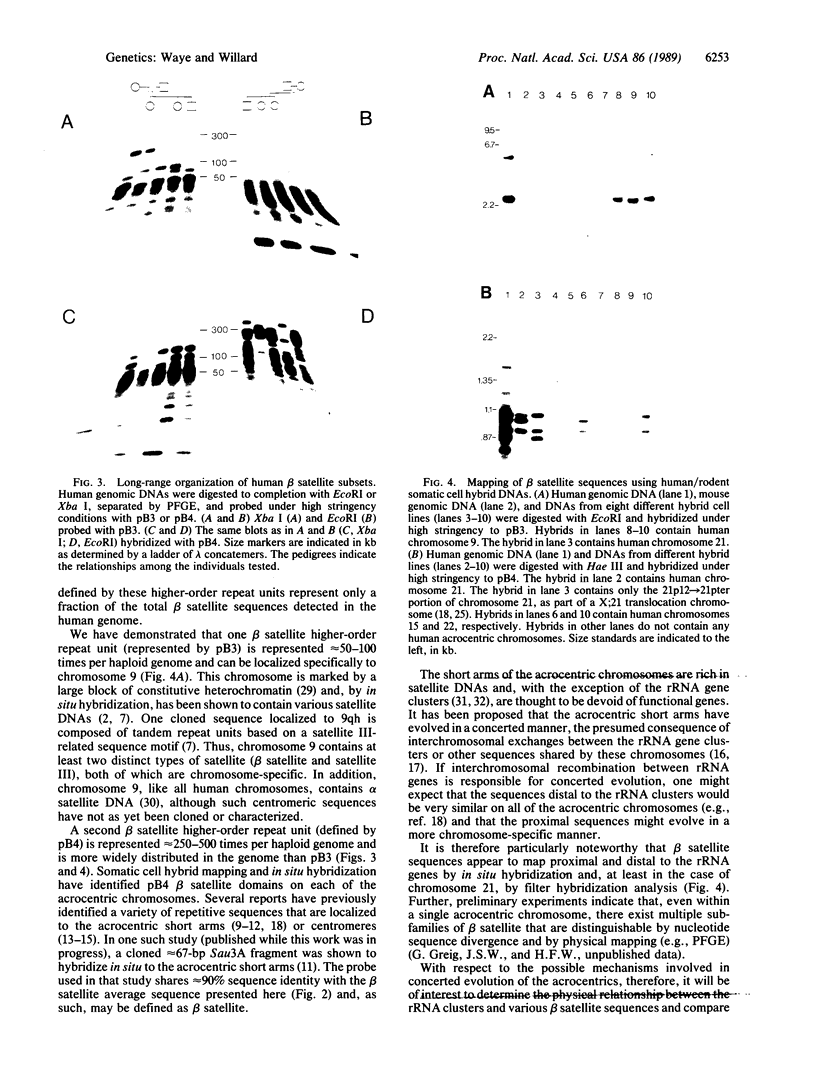
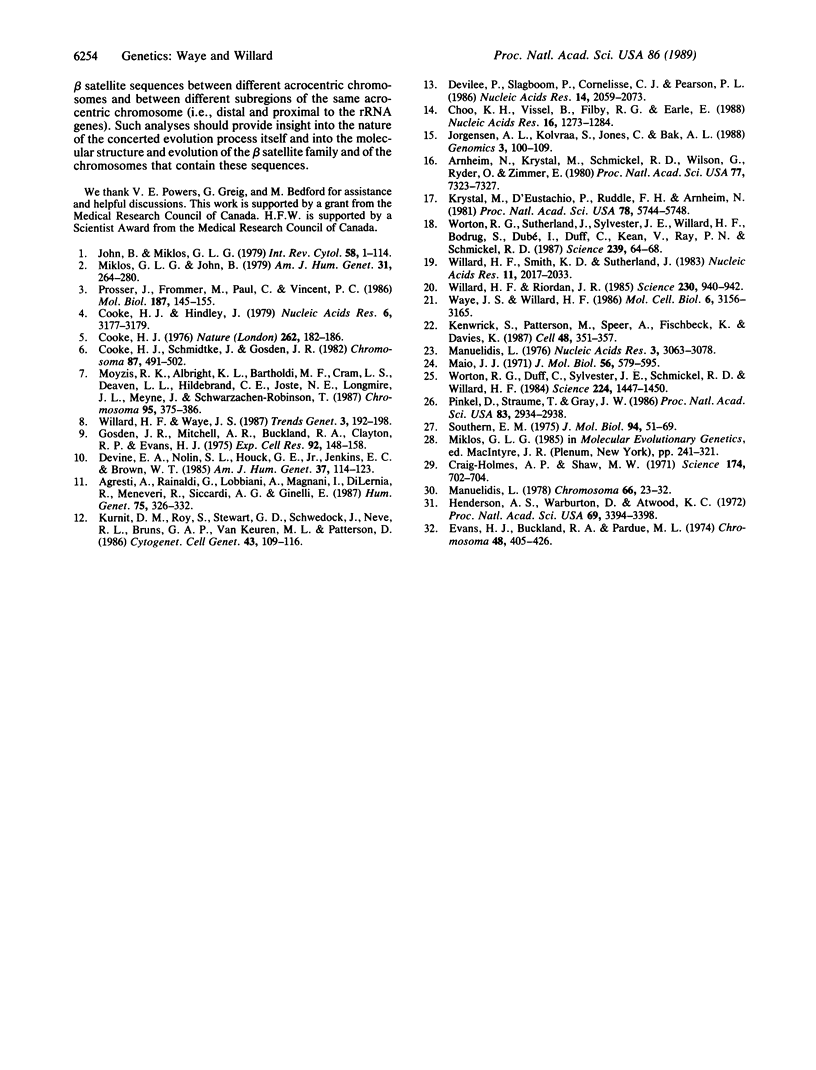
Images in this article
Selected References
These references are in PubMed. This may not be the complete list of references from this article.
- Agresti A., Rainaldi G., Lobbiani A., Magnani I., Di Lernia R., Meneveri R., Siccardi A. G., Ginelli E. Chromosomal location by in situ hybridization of the human Sau3A family of DNA repeats. Hum Genet. 1987 Apr;75(4):326–332. doi: 10.1007/BF00284102. [DOI] [PubMed] [Google Scholar]
- Arnheim N., Krystal M., Schmickel R., Wilson G., Ryder O., Zimmer E. Molecular evidence for genetic exchanges among ribosomal genes on nonhomologous chromosomes in man and apes. Proc Natl Acad Sci U S A. 1980 Dec;77(12):7323–7327. doi: 10.1073/pnas.77.12.7323. [DOI] [PMC free article] [PubMed] [Google Scholar]
- Choo K. H., Vissel B., Brown R., Filby R. G., Earle E. Homologous alpha satellite sequences on human acrocentric chromosomes with selectivity for chromosomes 13, 14 and 21: implications for recombination between nonhomologues and Robertsonian translocations. Nucleic Acids Res. 1988 Feb 25;16(4):1273–1284. doi: 10.1093/nar/16.4.1273. [DOI] [PMC free article] [PubMed] [Google Scholar]
- Cooke H. J., Hindley J. Cloning of human satellite III DNA: different components are on different chromosomes. Nucleic Acids Res. 1979 Jul 25;6(10):3177–3197. doi: 10.1093/nar/6.10.3177. [DOI] [PMC free article] [PubMed] [Google Scholar]
- Cooke H. J., Schmidtke J., Gosden J. R. Characterisation of a human Y chromosome repeated sequence and related sequences in higher primates. Chromosoma. 1982;87(5):491–502. doi: 10.1007/BF00333470. [DOI] [PubMed] [Google Scholar]
- Cooke H. Repeated sequence specific to human males. Nature. 1976 Jul 15;262(5565):182–186. doi: 10.1038/262182a0. [DOI] [PubMed] [Google Scholar]
- Craig-Holmes A. P., Shaw M. W. Polymorphism of human constitutive heterochromatin. Science. 1971 Nov 12;174(4010):702–704. doi: 10.1126/science.174.4010.702. [DOI] [PubMed] [Google Scholar]
- Devilee P., Slagboom P., Cornelisse C. J., Pearson P. L. Sequence heterogeneity within the human alphoid repetitive DNA family. Nucleic Acids Res. 1986 Mar 11;14(5):2059–2073. doi: 10.1093/nar/14.5.2059. [DOI] [PMC free article] [PubMed] [Google Scholar]
- Devine E. A., Nolin S. L., Houck G. E., Jr, Jenkins E. C., Brown W. T. Chromosomal localization of several families of repetitive sequences by in situ hybridization. Am J Hum Genet. 1985 Jan;37(1):114–123. [PMC free article] [PubMed] [Google Scholar]
- Gosden J. R., Mitchell A. R., Buckland R. A., Clayton R. P., Evans H. J. The location of four human satellite DNAs on human chromosomes. Exp Cell Res. 1975 Apr;92(1):148–158. doi: 10.1016/0014-4827(75)90648-5. [DOI] [PubMed] [Google Scholar]
- Henderson A. S., Warburton D., Atwood K. C. Location of ribosomal DNA in the human chromosome complement. Proc Natl Acad Sci U S A. 1972 Nov;69(11):3394–3398. doi: 10.1073/pnas.69.11.3394. [DOI] [PMC free article] [PubMed] [Google Scholar]
- John B., Miklos G. L. Functional aspects of satellite DNA and heterochromatin. Int Rev Cytol. 1979;58:1–114. doi: 10.1016/s0074-7696(08)61473-4. [DOI] [PubMed] [Google Scholar]
- Jørgensen A. L., Kølvraa S., Jones C., Bak A. L. A subfamily of alphoid repetitive DNA shared by the NOR-bearing human chromosomes 14 and 22. Genomics. 1988 Aug;3(2):100–109. doi: 10.1016/0888-7543(88)90139-5. [DOI] [PubMed] [Google Scholar]
- Kenwrick S., Patterson M., Speer A., Fischbeck K., Davies K. Molecular analysis of the Duchenne muscular dystrophy region using pulsed field gel electrophoresis. Cell. 1987 Jan 30;48(2):351–357. doi: 10.1016/0092-8674(87)90438-7. [DOI] [PubMed] [Google Scholar]
- Krystal M., D'Eustachio P., Ruddle F. H., Arnheim N. Human nucleolus organizers on nonhomologous chromosomes can share the same ribosomal gene variants. Proc Natl Acad Sci U S A. 1981 Sep;78(9):5744–5748. doi: 10.1073/pnas.78.9.5744. [DOI] [PMC free article] [PubMed] [Google Scholar]
- Kurnit D. M., Roy S., Stewart G. D., Schwedock J., Neve R. L., Bruns G. A., Van Keuren M. L., Patterson D. The 724 family of DNA sequences is interspersed about the pericentromeric regions of human acrocentric chromosomes. Cytogenet Cell Genet. 1986;43(1-2):109–116. doi: 10.1159/000132305. [DOI] [PubMed] [Google Scholar]
- Maio J. J. DNA strand reassociation and polyribonucleotide binding in the African green monkey, Cercopithecus aethiops. J Mol Biol. 1971 Mar 28;56(3):579–595. doi: 10.1016/0022-2836(71)90403-7. [DOI] [PubMed] [Google Scholar]
- Manuelidis L. Chromosomal localization of complex and simple repeated human DNAs. Chromosoma. 1978 Mar 22;66(1):23–32. doi: 10.1007/BF00285813. [DOI] [PubMed] [Google Scholar]
- Manuelidis L. Repeating restriction fragments of human DNA. Nucleic Acids Res. 1976 Nov;3(11):3063–3076. doi: 10.1093/nar/3.11.3063. [DOI] [PMC free article] [PubMed] [Google Scholar]
- Miklos G. L., John B. Heterochromatin and satellite DNA in man: properties and prospects. Am J Hum Genet. 1979 May;31(3):264–280. [PMC free article] [PubMed] [Google Scholar]
- Moyzis R. K., Albright K. L., Bartholdi M. F., Cram L. S., Deaven L. L., Hildebrand C. E., Joste N. E., Longmire J. L., Meyne J., Schwarzacher-Robinson T. Human chromosome-specific repetitive DNA sequences: novel markers for genetic analysis. Chromosoma. 1987;95(6):375–386. doi: 10.1007/BF00333988. [DOI] [PubMed] [Google Scholar]
- Pinkel D., Straume T., Gray J. W. Cytogenetic analysis using quantitative, high-sensitivity, fluorescence hybridization. Proc Natl Acad Sci U S A. 1986 May;83(9):2934–2938. doi: 10.1073/pnas.83.9.2934. [DOI] [PMC free article] [PubMed] [Google Scholar]
- Prosser J., Frommer M., Paul C., Vincent P. C. Sequence relationships of three human satellite DNAs. J Mol Biol. 1986 Jan 20;187(2):145–155. doi: 10.1016/0022-2836(86)90224-x. [DOI] [PubMed] [Google Scholar]
- Southern E. M. Long range periodicities in mouse satellite DNA. J Mol Biol. 1975 May 5;94(1):51–69. doi: 10.1016/0022-2836(75)90404-0. [DOI] [PubMed] [Google Scholar]
- Waye J. S., Willard H. F. Structure, organization, and sequence of alpha satellite DNA from human chromosome 17: evidence for evolution by unequal crossing-over and an ancestral pentamer repeat shared with the human X chromosome. Mol Cell Biol. 1986 Sep;6(9):3156–3165. doi: 10.1128/mcb.6.9.3156. [DOI] [PMC free article] [PubMed] [Google Scholar]
- Willard H. F., Riordan J. R. Assignment of the gene for myelin proteolipid protein to the X chromosome: implications for X-linked myelin disorders. Science. 1985 Nov 22;230(4728):940–942. doi: 10.1126/science.3840606. [DOI] [PubMed] [Google Scholar]
- Willard H. F., Smith K. D., Sutherland J. Isolation and characterization of a major tandem repeat family from the human X chromosome. Nucleic Acids Res. 1983 Apr 11;11(7):2017–2033. doi: 10.1093/nar/11.7.2017. [DOI] [PMC free article] [PubMed] [Google Scholar]
- Worton R. G., Duff C., Sylvester J. E., Schmickel R. D., Willard H. F. Duchenne muscular dystrophy involving translocation of the dmd gene next to ribosomal RNA genes. Science. 1984 Jun 29;224(4656):1447–1449. doi: 10.1126/science.6729462. [DOI] [PubMed] [Google Scholar]
- Worton R. G., Sutherland J., Sylvester J. E., Willard H. F., Bodrug S., Dubé I., Duff C., Kean V., Ray P. N., Schmickel R. D. Human ribosomal RNA genes: orientation of the tandem array and conservation of the 5' end. Science. 1988 Jan 1;239(4835):64–68. doi: 10.1126/science.3336775. [DOI] [PubMed] [Google Scholar]




